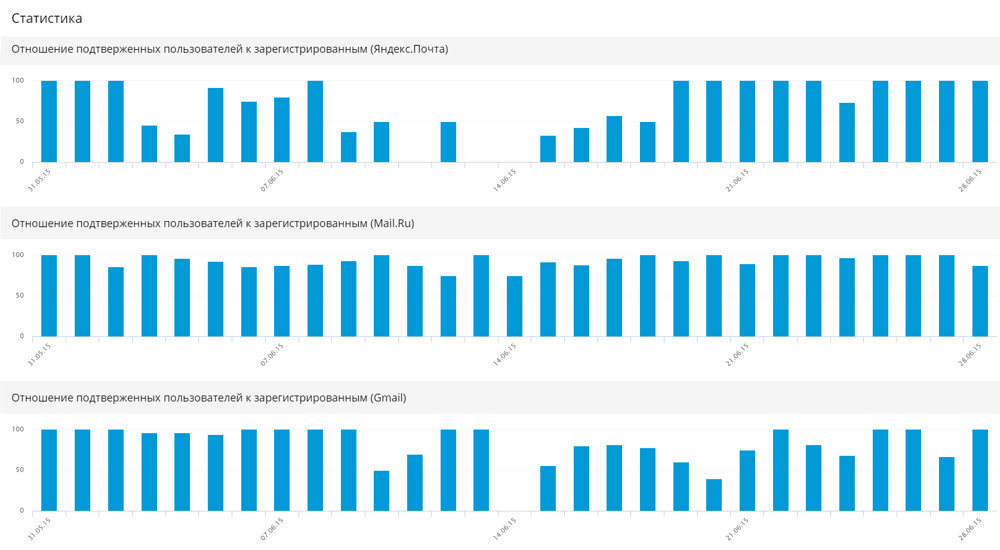As we received + 200% of regular users, correcting the newsletter

It’s easy to lose sight of an important part of a project when you develop your startup. So it was with us. One spring day, we suddenly started receiving letters with complaints from people who could not register on our service. At first we decided that the fault was caused by some kind of software failure, but the situation turned out to be much more serious.
The users not only stopped receiving letters confirming the registration, but also our entire mailing service was “cracking at the seams”, which hit the conversion hard. Within a few days, we found obvious shortcomings and errors in the mailing list, corrected them and returned regular users.
')
Most likely, most startups have problems with mailing to some extent. To help you avoid stepping on our rakes, we identified three major "childish" mistakes that we made and want to share with you ways to eliminate them.
1. Letters do not reach the addressees or get in spam
I will say right away that this is not about some mass weekly distribution of materials, but about ordinary service distribution of letters to our users. We send notifications about problems with sites, about found threats, successful treatments, registration, etc. Of course, many thousands of such letters are sent every day.
The first, "lying on the surface" problem, which we learned from our users, was regular non-delivery of letters.
There are a lot of tools to track the effectiveness of mailing, but to detect the source of our problem, we made a panel showing the ratio of confirmed letters to the number sent out for each mail service separately. Now we could narrow the search for a problem. The picture looked like this:

Obvious difficulties were observed with Google and Yandex. It turned out that literally 50% of the letters do not reach people or get in spam (middle of the diagram). The problem also extended to mail for the Google and Yandex domain. During the proceedings it turned out that the cause of the problem was several circumstances at once:
- Our users often instead of turning off the notification notifications in their panel pressed the “spam” button in their mailboxes.
- Google and Yandex mail servers often blocked our messages for a while because of their excess of the “healthy person” limit on the amount of information sent from a single IP.
What we did to solve the problem:
- We wrote several requests to the Yandex support service, but the problem did not dare. Then we took a letter to the Yandex office asking for the need to solve the problem. The support guys contacted us within a few days and the situation returned to normal.
- With Gmail, everything was a bit more complicated. First of all, we once again went over the points of recommendations for Google mailings .
As part of our letters there was no link "Unsubscribe from the mailing list". It was necessary to correct the defect and send a request to Google for rechecking. Of course, we were informed that the letters will now begin to be delivered to the addressees, and their automatic entry into “spam” will automatically pass after some time. And so it happened, but literally in a week the letters to Google again stopped coming. We looked at the server log. It turned out that the SMTP limit of Google worked and does not allow new letters from our address. Found a feedback form

wrote through it to Google about the problem. Honestly, they did not expect a miracle, but after 2 hours everything worked. To date, new problems with the delivery of letters is not observed.
2. Letters are not beautiful
Having solved the delivery problem, we decided to take a closer look at the templates of our letters. Here we also had an unpleasant surprise. Everyone likes to get beautiful letters from good services. We believed that ours are just like that. However, this was not the case.
Last time we dealt with templates a few months ago. During this time, most of the graphical interface elements have been improved and changed. In the letters, moreover, that the images did not correspond to the new style of service, and in some cases (due to an oversight of the debuggers), the images did not match the letter pattern. In the letter about the service connection, for example, there was an image from the letter about the balance replenishment.
All the dull old images had to be urgently redrawn. Difference of old pictures from new ones are visible, to put it mildly, immediately (I will give three pieces):

At first glance it would be possible to dwell on this, but something was tormenting us. We started looking at the letter templates further.
3. In the subject line and in the title write the problem, the solution of which you sell.
Here we come to the most, in my opinion, an important point. We paid attention to the subject and title of some letters that we sent to our users. It turned out that in some cases, instead of telling people about a problem, we told them about spending balance. Most services do not allow such errors - we made.
Instead of writing: “Site protection is disabled”, we wrote: “There are not enough funds on your balance to extend the service”. There were also other semantic errors.
Just trying on such content on you as well as we will not understand what the problem is and what is required of you. Thus came the realization that it was necessary to directly inform people about the existence of a problem with the service for which they came to us. I had to fix it.
As a result, our letters began to look like this (example of a letter about disabling protection):

How improvements affected conversion
We received + 200% within 1 week to the number of regular users due to corrections and improvement of distribution letters. Previously, some people simply did not receive letters, and some of those who received notifications simply could not understand what to do next.
We also have tools that we use daily to track the effectiveness of letter delivery. Actually, the case described by me and references to tools should be enough for you if you are experiencing a problem similar to our distribution.
PS
If you want to try to improve the quality of your service, and with it the conversion to regular users - try to work on your mailing list templates. This will help! At least it helped us.
Source: https://habr.com/ru/post/293042/
All Articles